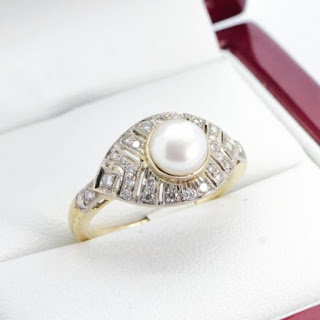The Luxury And Elegance Of Vintage Jewellery
Vintage jewellery known by many names. It is generally referred to as estate jewellery or antique jewellery. The only real demand that a chunk of jewellery should need to be thought of vintage, is that’s must be from a special period of time than the one that is being lived at the moment. Certain time periods and eras jewellery are more desirable to collectors than others. The time period, quality, and design of a piece of jewellery tend to be the deciding factors when it comes to pricing these antiques.

The most popular time periods for collectors of estate jewellery include Georgian, Early Victorian, Mid-Victorian, Late Victorian, the Arts and Crafts era, Art Nouveau, Edwardian, Art Deco and Retro. Retro is a commonly used term and in the case of antique jewellery, it is referring to any pieces that were made after World War II.
Georgian jewellery (1714–1837) was handmade and is difficult to find. Leaves and birds were popular jewellery subjects of the time as were precious stones.
Early Victorian jewellery (1837–1855) was also known as romantic jewellery and featured designs inspired by nature etched delicately into gold. Lockets and brooches were very popular.
The Mid-Victorian jewellery (1856–1880) was also called grand jewellery and were generally made with heavy and dark stones such a jet, onyx, amethyst, and garnet. This jewellery was considered to be “mournful”.
Late Victorian jewellery (1885–1900) featured a lot of star and crescent designs using diamonds and brighter gemstones.
The Arts and Crafts jewellery (1894–1923) saw a return to handmade jewellery often with simplistic patterns with uncut but colourful stones.
Art Nouveau jewellery (1895–1915) was primarily created by a French jewellery designer named Rene Jules Lalique and featured nature-inspired subjects such as butterflies and flowers.
Edwardian Jewellery (1901–1915) is so named because this is the time period when Queen Victoria died and Prince Edward became King Edward. These pieces are known for their expensive gemstones and elaborate structure.
Art Deco jewellery (1915–1935) is known best for its linear aesthetic, geometric shapes and bright colours. Necklaces were worn very long and bracelets were worn in bangles on the wrist. Most of the jewellery designs from this period were influenced by African, Egyptian and Japanese themes.
Retro Jewellery (1945–1960) was designed with a focus on Hollywood glamour and included very bright, strong and elaborate pieces. The large cocktail rings and charm bracelets that come from this era are still very popular.
Vintage jewellery is so much more than just another accessory. It is a piece of history. Most collectors feel that they need to be gathered quite simply objects. Many times these collectors get to hear the stories behind the specific pieces and learn about the lives that were lived while each item was being worn. Vintage jewellery offers beauty, style and a connection to the past for the wearer.

The most popular time periods for collectors of estate jewellery include Georgian, Early Victorian, Mid-Victorian, Late Victorian, the Arts and Crafts era, Art Nouveau, Edwardian, Art Deco and Retro. Retro is a commonly used term and in the case of antique jewellery, it is referring to any pieces that were made after World War II.
Georgian jewellery (1714–1837) was handmade and is difficult to find. Leaves and birds were popular jewellery subjects of the time as were precious stones.
Early Victorian jewellery (1837–1855) was also known as romantic jewellery and featured designs inspired by nature etched delicately into gold. Lockets and brooches were very popular.
The Mid-Victorian jewellery (1856–1880) was also called grand jewellery and were generally made with heavy and dark stones such a jet, onyx, amethyst, and garnet. This jewellery was considered to be “mournful”.
Late Victorian jewellery (1885–1900) featured a lot of star and crescent designs using diamonds and brighter gemstones.
The Arts and Crafts jewellery (1894–1923) saw a return to handmade jewellery often with simplistic patterns with uncut but colourful stones.
Art Nouveau jewellery (1895–1915) was primarily created by a French jewellery designer named Rene Jules Lalique and featured nature-inspired subjects such as butterflies and flowers.
Edwardian Jewellery (1901–1915) is so named because this is the time period when Queen Victoria died and Prince Edward became King Edward. These pieces are known for their expensive gemstones and elaborate structure.
Art Deco jewellery (1915–1935) is known best for its linear aesthetic, geometric shapes and bright colours. Necklaces were worn very long and bracelets were worn in bangles on the wrist. Most of the jewellery designs from this period were influenced by African, Egyptian and Japanese themes.
Retro Jewellery (1945–1960) was designed with a focus on Hollywood glamour and included very bright, strong and elaborate pieces. The large cocktail rings and charm bracelets that come from this era are still very popular.
Vintage jewellery is so much more than just another accessory. It is a piece of history. Most collectors feel that they need to be gathered quite simply objects. Many times these collectors get to hear the stories behind the specific pieces and learn about the lives that were lived while each item was being worn. Vintage jewellery offers beauty, style and a connection to the past for the wearer.


Comments
Post a Comment